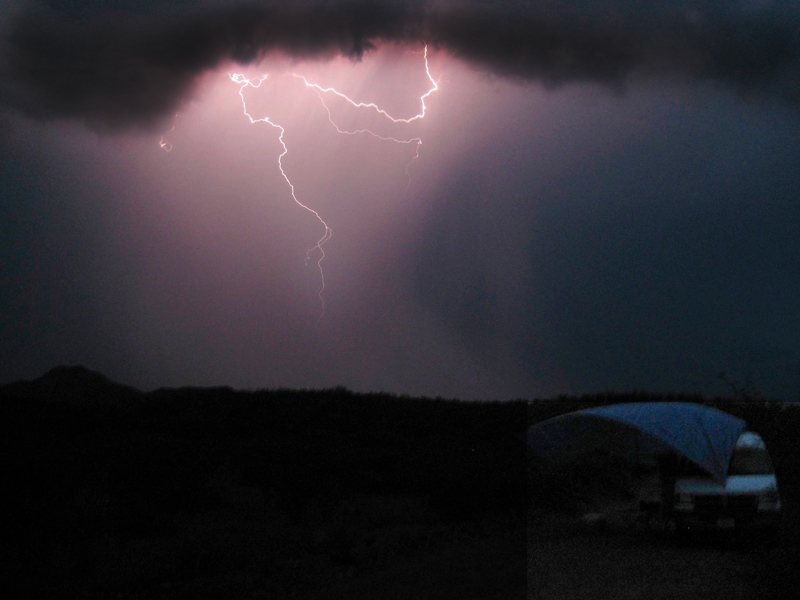Wow es ist schon ein paar Wochen her, seit meinem letzten Beitrag, und ich bin ein bisschen peinlich, nachdem wir es so lange gehen. Was habe ich so gemacht? Nicht Ganzes nicht. Keine beeindruckende Sammelreisen, keine neuen Spezies oder Entdeckungen. Eigentlich habe ich an einem Mikroskop seziert Genitalien gesessen oder Databasing parasitären Fliegen. Ich muss einen Folgebeitrag schreiben, um ein bisschen mehr darauf einzugehen…
Aber für den Moment, Hier ist ein Bild vom letzten August. Ich stand auf einem offenen Stück Chihuahua-Wüste direkt außerhalb von Douglas, Arizona; satte eine Meile von der mexikanischen Grenze entfernt. Ich kam am Abend mit meinem Sammelkollegen an, Mikrolepidopterist Peter Jump, und wir hatten gerade unser Lager aufgeschlagen, als das Donnergrollen näher rückte. Abgesehen von den ausgestorbenen Schlackenkegeln, die uns umgeben, und einem gelegentlichen illegalen Einwanderer, wir waren die einzigen (und am höchsten) Sache um Meilen herum. Aber der Blitz war zu hart, um ihm zu widerstehen, Ich brauche ein Bild! Aber ich hatte keinen Kabelauslöser, auch kein Stativ, oder sogar eine gute Kamera. Was also tun… Ich entschied mich für die geniale Option, draußen zu stehen 40 Minuten mit meinem Canon Point-and-Shoot. Ich vermisste 99% von jedem Schuss, den ich gemacht habe, während mit jeder vergehenden Minute der Blitz näher kam. Schließlich, Ich bin über dieses anständige Bild gestolpert. Der Sturm endete kurz, wir kauern im auto (das man auf dem Bild gerade erkennen kann) während der Blitz näher kam und es eine Stunde lang auf uns nieselte und dann weiterzog. Das Sammeln an diesem Abend war beeindruckend. Es waren so viele Motten in der Falle, dass alles zerschlagen war. Es gelang mir, eine Handvoll guter Exemplare zu retten, aber Lektion gelernt für das nächste Mal.


Dazzling. I’ve found my best blacklighting also when a whopper of a storm is brewing – don’t know what it is about that weather that makes the bugs so active.
I’ve noticed the odd night here or there where the moths in the trap seemed to be exceptionally ratty, and I’ve wondered at the cause and how to prevent it. The fact that it wasn’t happening every night ruled out the trap itself as the ultimate cause, though if, as you say, it’s due to too many individuals inside at once then I suppose the trap is partly to blame. How to get around it? Larger trap? Two traps together? Turn it off halfway through the night? (But what about the late-night flyers?)
I think there are a handful of factors, first and foremost being the percentage of strong flying moths (like Sphingidae) or beetles. But that seems pretty obvious, 40 flapping sphingids in the trap turns it into a vortex, or beetles run around destroying things.
I think it also depends on the killing agent you are using, wind, and how well the trap is sealed. On the most humid of humid nights acetate seems to start failing, where cyanide in the trap would be ideal.
I’m headed to Southern TX in a few weeks and I’ve made some preparations – I’ve built screens that will fit around my traps to keep out the big stuff, and I’ve prepared to have three jars of acetate per trap. Hopefully, that will do it!! The alternative is to completely swap out the traps two or three times over the course of the night, which is something I know people do (sigh).
Back in the day, we used BOTH ethyl acetate and potassium cyanide, because acetate was good for the smaller moths and cyanide provided a faster knock-out of the heavier, destructive, tromping beetles. Moist, wet weather definitely plays a part; you certainly want your trap dry for the equipment, both killing agents to work effectively, and the quality of the catch. We also used a timer for the UV light (both AC and DC) – one of those plug-in varieties that allow you to set the hours of when something should be on and off. This was mainly due to the fact that we had up to 20 traps across 3 counties to set and collect once a week for 4 months every summer for over 10 Jahre. I suspect the timer could easily be adapted to collect at certain or multiple time periods in any given night, depending on your goals.
ps – Chris, what’s this southernfriedscience that I see in your address? If I go to your usual WordPress, Seabrooke and your reply do not show.
That’s a ton of traps! What was this survey work for?
Und- I have moved my entire blog to the southern fried science network, the old wordpress blog will only exist as an archive and no updates will be made. So please change your links to the new page, Dank!
Not being a collector (except of photographs), I live trap so the acetate/cyanide wouldn’t be something I’d need to think about. But I can see how beetles and heavy moths could really stir things up. I hadn’t really paid attention to their numbers in the catch on those nights versus others. (I can’t even imagine 40 sphingids in the trap at once! A busy sphinx night for me might be a dozen). Screens are an interesting thought. I wonder how many smaller moths you’d lose by having something they could bump into or land on.
I’m not a collector anymore, either, Seabrooke. Do you have any sample pics of the plates in your new book?
Seabrooke, I found a couple pics of your book plates online. Nizza! I like the natural poses over pinned and stretched moth specimens. Good job.